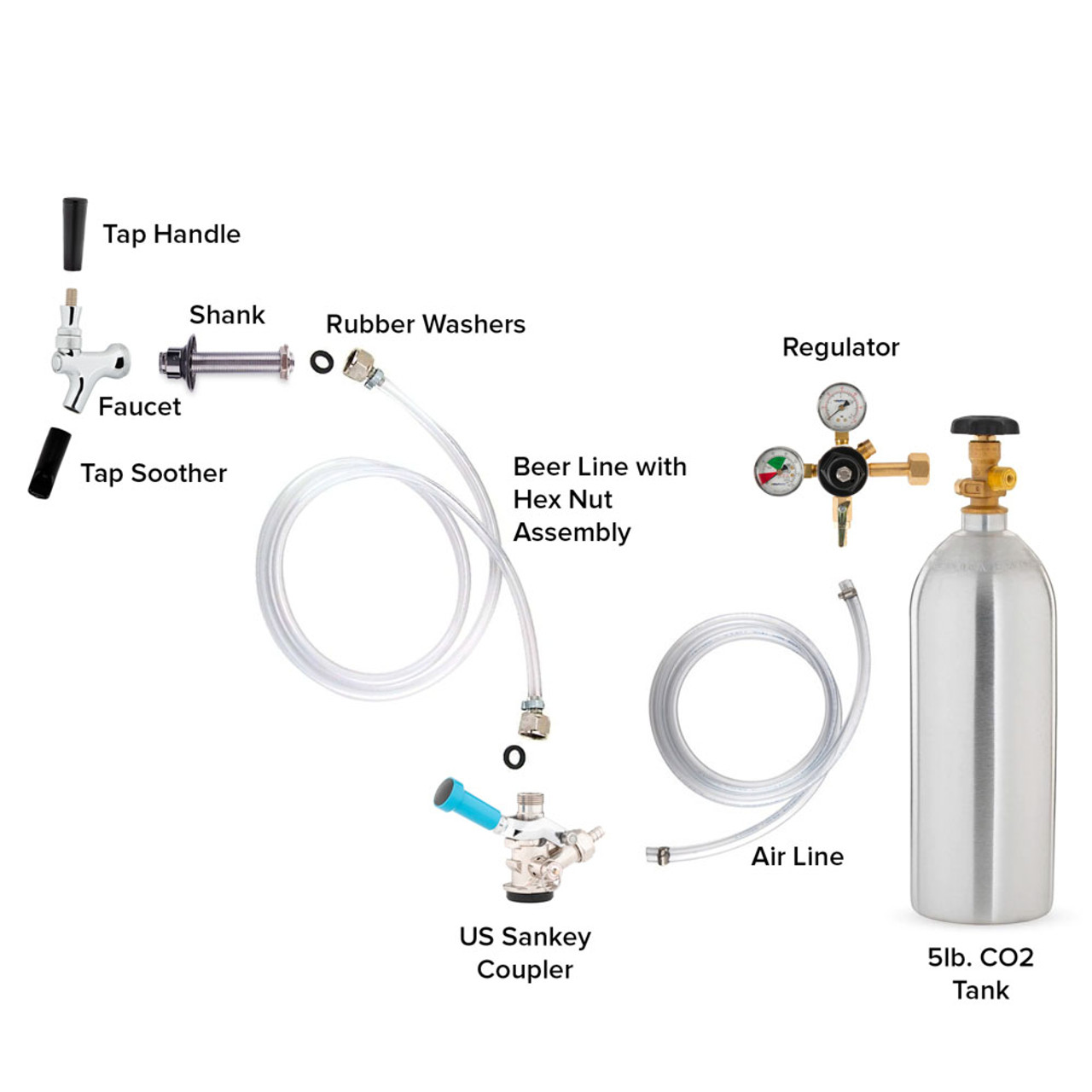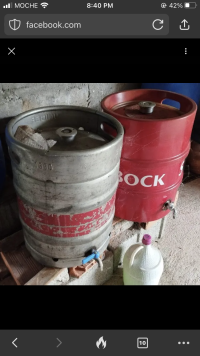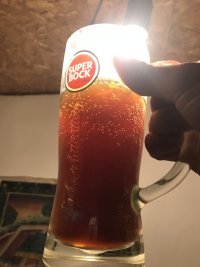You are using an out of date browser. It may not display this or other websites correctly.
You should upgrade or use an alternative browser.
You should upgrade or use an alternative browser.

Help Support Homebrew Talk:
This site may earn a commission from merchant affiliate
links, including eBay, Amazon, and others.
NSMikeD
Well-Known Member
Can i get an opinion on these kegs that have just come up for sale. I have no idea about kegs but i dont recall seeing taps on them
as this is a beginner forum I'l try to limit my reply to the basics. Kegging is great and I keg and hate bottling. That being said there are basically 2 types of kegs, sanka and corny. Basically sanka kegs are what you see in bars and college parties. The CO2 in and Beer out are combined into a single connection. Those kegs lok like standard 1/2 barrels that are 15.5 gallons
Homebrewers usually use corny kegs with separate connections for CO2 in and beer out. Likely, because homebrewers initially recycled used soda kegs (corny style). Those soda kegs are 5-gallon size
I suspect the 5-gallon batch standard for homebrewing was partly due to the size of those soda kegs. But today, homebrew suppliers have responded to the various needs and wants of a more diversified homebrew market, and kegs are readily available in different sizes.
I suggest spending time perfecting your homebrewing method so you rely more on memory and instinct and less on instruction sheets (like a chef who will have a recipe, but can execute it without looking) and take note of your consumption habits, which may include giving away more or less of your brews after those initial batches
I recommend matching the keg size to your personal needs and wants. For example, I now brew 2.5 gallon batches. I found that 5 gallons of beer was not for me. Why 2.5 gallons? Well, that's about 20 pints, which often will last me about a month. I like to try commercial craft beer due to the seemingly endless varieties now available in the States. Let's say I want to brew a Vienna lager. I can pick up a dozen different commercial beers of that style, experience the differences, and come up with a recipe I think I'd like. Since I like to brew different styles of beers, 2.5-gallon batches free me up to sample more commercial beers and tweak the recipes after evaluating how the first batch came out. Another plus is that if a family member gives me a beer kit, I can simply divide the kit in half to fit my equipment.
As you can see, my experience learning my needs and wants enabled me to forego the standard 5-gallon keg route and opt for 2,5-gallon kegs. I assume I was not alone, as that keg size was available at a reasonable price from the homebrewer suppliers.
Lastly, I love kegging; I would focus on temperature control before I added kegging to my equipment. Fermentation temperature can have a discernable impact on the taste of your beer. While I don't think it's needed for a beginner brewer, IMO it is a logical variable to address into intermediate brewing.
Bagarge
Well-Known Member
Thanks for the detailed response my friend!as this is a beginner forum I'l try to limit my reply to the basics. Kegging is great and I keg and hate bottling. That being said there are basically 2 types of kegs, sanka and corny. Basically sanka kegs are what you see in bars and college parties. The CO2 in and Beer out are combined into a single connection. Those kegs lok like standard 1/2 barrels that are 15.5 gallons
Homebrewers usually use corny kegs with separate connections for CO2 in and beer out. Likely, because homebrewers initially recycled used soda kegs (corny style). Those soda kegs are 5-gallon size
I suspect the 5-gallon batch standard for homebrewing was partly due to the size of those soda kegs. But today, homebrew suppliers have responded to the various needs and wants of a more diversified homebrew market, and kegs are readily available in different sizes.
I suggest spending time perfecting your homebrewing method so you rely more on memory and instinct and less on instruction sheets (like a chef who will have a recipe, but can execute it without looking) and take note of your consumption habits, which may include giving away more or less of your brews after those initial batches
I recommend matching the keg size to your personal needs and wants. For example, I now brew 2.5 gallon batches. I found that 5 gallons of beer was not for me. Why 2.5 gallons? Well, that's about 20 pints, which often will last me about a month. I like to try commercial craft beer due to the seemingly endless varieties now available in the States. Let's say I want to brew a Vienna lager. I can pick up a dozen different commercial beers of that style, experience the differences, and come up with a recipe I think I'd like. Since I like to brew different styles of beers, 2.5-gallon batches free me up to sample more commercial beers and tweak the recipes after evaluating how the first batch came out. Another plus is that if a family member gives me a beer kit, I can simply divide the kit in half to fit my equipment.
As you can see, my experience learning my needs and wants enabled me to forego the standard 5-gallon keg route and opt for 2,5-gallon kegs. I assume I was not alone, as that keg size was available at a reasonable price from the homebrewer suppliers.
Lastly, I love kegging; I would focus on temperature control before I added kegging to my equipment. Fermentation temperature can have a discernable impact on the taste of your beer. While I don't think it's needed for a beginner brewer, IMO it is a logical variable to address into intermediate brewing.
Basically i want to sell alot of my beer so size is what i am after. Where i live everybody sells their home produced wine but there is nobody doing beer.
My initial question was about the taps on the kegs in the picture. They are beer kegs for sure but i have never seen a tap on the barrel. They just came up for sale in the area and the person selling them was using them for aguadente ( a distillation of the wine pulp produced here ).
What i would like to know is can i store and age my beer in these kegs and connect co2 lines in? I would much prefer kegging larger quantities than bottling as i have to obviously source the bottles.
I just cant remember ever seeing taps on the bottom of a keg…
Edit: they are going dirt cheap at €50 for a 50 litre keg but i dont want to buy them if that tap will be an issue
NSMikeD
Well-Known Member
This is for US sankey kegs. The coupler has a connection for the line in for the CO2. It then has a line out for the beer to a serving tap. Beer will most certainly condition in a kegThanks for the detailed response my friend!
Basically i want to sell alot of my beer so size is what i am after. Where i live everybody sells their home produced wine but there is nobody doing beer.
My initial question was about the taps on the kegs in the picture. They are beer kegs for sure but i have never seen a tap on the barrel. They just came up for sale in the area and the person selling them was using them for aguadente ( a distillation of the wine pulp produced here ).
What i would like to know is can i store and age my beer in these kegs and connect co2 lines in? I would much prefer kegging larger quantities than bottling as i have to obviously source the bottles.
I just cant remember ever seeing taps on the bottom of a keg…
fwiw, even the most famous commerical craft brewers in the states will brew small batches on their old homebrew kits before deciding on a recipe they can scale up for sale.
how would your customers get your beer - would you serve from the taps to consume on premise like a bar or would they take home in some sort of container like bottles, cans or growlers.
Cartainly you can bottle, can or serve in a growler from a keg. There are kits that use a second CO2 line to a bottle filler to transfer beer from a keg to a bottle to keep the O2 out of the bottle. This is common for filling bottles to send to beer competitions.
Canning seems to be the preferred method for micro brewers to get their beer to the public. There are canning kits for the home brewer, again to transfer from a keg after the beer has carbonated and conditioned in the keg. A canning seamer (the device that put the lid on the can) does have a bigger start up cost but aluminum cans cost a little less than US$1 per can.
Growlers are just large bottles, usually with a ceramic flip top or a screw on plastic top and come on 1/2, full and 2 liters. In the States, you either rent (with a deposit) or buy your own growler and bring it to the brewery to fill and bring back home.

The spigots on those keg look like a DIY modification to me. I think you should ask the seller what the modified kegs were used for.
I also think you might get more/better responses if you post new questions to new threads. But I could be wrong about that.
I also think you might get more/better responses if you post new questions to new threads. But I could be wrong about that.
Bagarge
Well-Known Member
I would most likely be transferring to bottles or containers that people would bring to be filled. Or, bottle them from the keg. Im just looking at maturing beer on larger quantities in a singular keg rather than bottles everywhere. Plus i like the idea of force carbonating.This is for US sankey kegs. The coupler has a connection for the line in for the CO2. It then has a line out for the beer to a serving tap. Beer will most certainly condition in a keg
fwiw, even the most famous commerical craft brewers in the states will brew small batches on their old homebrew kits before deciding on a recipe they can scale up for sale.
how would your customers get your beer - would you serve from the taps to consume on premise like a bar or would they take home in some sort of container like bottles, cans or growlers.
Cartainly you can bottle, can or serve in a growler from a keg. There are kits that use a second CO2 line to a bottle filler to transfer beer from a keg to a bottle to keep the O2 out of the bottle. This is common for filling bottles to send to beer competitions.
Canning seems to be the preferred method for micro brewers to get their beer to the public. There are canning kits for the home brewer, again to transfer from a keg after the beer has carbonated and conditioned in the keg. A canning seamer (the device that put the lid on the can) does have a bigger start up cost but aluminum cans cost a little less than US$1 per can.
Growlers are just large bottles, usually with a ceramic flip top or a screw on plastic top and come on 1/2, full and 2 liters. In the States, you either rent (with a deposit) or buy your own growler and bring it to the brewery to fill and bring back home.
View attachment 842386
What is the use of the tap at tje bottom of the pic i sent? Im trying to work out wether they are worth buying

$176.97
1pc Commercial Keg Manifold 2" Tri Clamp,Ball Lock Tapping Head,Pressure Gauge/Adjustable PRV for Kegging,Fermentation Control
hanhanbaihuoxiaoshoudian

$53.24
1pc Hose Barb/MFL 1.5" Tri Clamp to Ball Lock Post Liquid Gas Homebrew Kegging Fermentation Parts Brewer Hardware SUS304(Liquid Hose Barb)
yunchengshiyanhuqucuichendianzishangwuyouxiangongsi

$20.94
$29.99
The Brew Your Own Big Book of Clone Recipes: Featuring 300 Homebrew Recipes from Your Favorite Breweries
Amazon.com

$58.16
HUIZHUGS Brewing Equipment Keg Ball Lock Faucet 30cm Reinforced Silicone Hose Secondary Fermentation Homebrew Kegging Brewing Equipment
xiangshuizhenzhanglingfengshop

$7.79 ($7.79 / Count)
Craft A Brew - LalBrew Voss™ - Kveik Ale Yeast - For Craft Lagers - Ingredients for Home Brewing - Beer Making Supplies - (1 Pack)
Craft a Brew

$33.99 ($17.00 / Count)
$41.99 ($21.00 / Count)
2 Pack 1 Gallon Large Fermentation Jars with 3 Airlocks and 2 SCREW Lids(100% Airtight Heavy Duty Lid w Silicone) - Wide Mouth Glass Jars w Scale Mark - Pickle Jars for Sauerkraut, Sourdough Starter
Qianfenie Direct

$53.24
1pc Hose Barb/MFL 1.5" Tri Clamp to Ball Lock Post Liquid Gas Homebrew Kegging Fermentation Parts Brewer Hardware SUS304(Liquid Hose Barb)
Guangshui Weilu You Trading Co., Ltd

$22.00 ($623.23 / Ounce)
AMZLMPKNTW Ball Lock Sample Faucet 30cm Reinforced Silicone Hose Secondary Fermentation Homebrew Kegging joyful
无为中南商贸有限公司

$10.99 ($31.16 / Ounce)
Hornindal Kveik Yeast for Homebrewing - Mead, Cider, Wine, Beer - 10g Packet - Saccharomyces Cerevisiae - Sold by Shadowhive.com
Shadowhive

$479.00
$559.00
EdgeStar KC1000SS Craft Brew Kegerator for 1/6 Barrel and Cornelius Kegs
Amazon.com
Bagarge
Well-Known Member
That is what i was thinking. They look to be modified. The person selling them was using them to store hard liquor in them… if the spigots are a modification will i have problems ageing my beer in there with a co2 hook up?The spigots on those keg look like a DIY modification to me. I think you should ask the seller what the modified kegs were used for.
I also think you might get more/better responses if you post new questions to new threads. But I could be wrong about that.
I would be worried about how much pressure the spigots and the seals around them can handle.The person selling them was using them to store hard liquor in them… if the spigots are a modification will i have problems ageing my beer in there with a co2 hook up?
Bagarge
Well-Known Member
Would that also be the case if i were to add priming sugar to the keg and mature without CO2? I will have to go and look at them i suppose…I would be worried about how much pressure the spigots and the seals around them can handle.
Agree with mac, I don't think I'd trust those with co2. You could age the beer in those then transfer to kegs or bottles to carbonate when it is where you want it.
Bagarge
Well-Known Member
I guess the spigot would allow me to try easily. Like i asked mac, could i prime the beer in that keg or would it also create too much pressure?Agree with mac, I don't think I'd trust those with co2. You could age the beer in those then transfer to kegs or bottles to carbonate when it is where you want it.
Pressure is pressure. Doesn't matter if it comes from priming sugar or a CO2 tank.
NSMikeD
Well-Known Member
Would that also be the case if i were to add priming sugar to the keg and mature without CO2? I will have to go and look at them i suppose…
priming or using CO2 is pretty much the same for carbonation. The CO2 is also needed to maintain carbonation and keep O2 air out as you deplete the beer. CO2 takes up the empty space and keeps the beer from going flat.
I'd stay away from those kegs. Who knows what they were used for with the added spigots and what mods were made to the sealed top hardware to prevent a vacuum so fluid could be poured out of the spigot.
Last edited:
Bagarge
Well-Known Member
GotchaPressure is pressure. Doesn't matter if it comes from priming sugar or a CO2 tank.
Pressure is pressure. Doesn't matter if it comes from priming sugar or a CO2 tank.
Bagarge
Well-Known Member
Yeah i guess i will swerve these kegs. I dont need them right now i have many aspects to work on before i get to large kegs. It was just that they are dirt cheap and thought it was a good opportunity.priming or using CO2 is pretty much the same for carbonation. The CO2 is also need to maintain carbonation and keep O2 air out as you deplete the beer. CO2 takes up the empty space and keeps the beer from going flat.
I'd stay away from those kegs. Who knows what they were used for with the added spigots and what mods were made to the sealed top hardware to prevent a vacuum so fluid could be poured out of the spigot.
Thanks guys you most definitely saved me a few bucks
NSMikeD
Well-Known Member
Yeah i guess i will swerve these kegs. I dont need them right now i have many aspects to work on before i get to large kegs. It was just that they are dirt cheap and thought it was a good opportunity.
Thanks guys you most definitely saved me a few bucks
This forum helped me save a lot of money with DIY tips and hardware purchases.
I didn't read deeply into the posts about kegs but I would suggest looking at newer kegs for your use. Suggesting you want to sell brewed beer I'd really be concerned with proper cleaning and sanitation.
Each place has it's own laws about that so I would look at your area before buying up used equipment. With the wine industry nearby you should be able to find proper equipment being sold that you could use.
You have brewed one batch of beer. Take the right steps to understand brewing better before investing in a future you're not sure of.
Each place has it's own laws about that so I would look at your area before buying up used equipment. With the wine industry nearby you should be able to find proper equipment being sold that you could use.
You have brewed one batch of beer. Take the right steps to understand brewing better before investing in a future you're not sure of.
Aside from a possible issue accessing the top port, hard liquor is served still, no carbonation.Yeah i guess i will swerve these kegs. I dont need them right now i have many aspects to work on before i get to large kegs. It was just that they are dirt cheap and thought it was a good opportunity.
Beer on the other hand relies on proper carbonation to be tasting good. That means the keg and beer needs to be carbonated and dispensed under pressure when serving.
You cannot simply dispense carbonated beer under pressure through that spigot on the bottom: the beer would squirt out at high speed, since there is no resistance.
That's why we use a certain length of (flexible) tubing of a rather thin inner diameter between the keg and faucet to create some back pressure. That keeps the beer carbonated on its way to the faucet, and prevents it from excessive foaming too.
Bagarge
Well-Known Member
I would seriously like to thank everyone here that has offered advice. You are all absolute legends! I couldnt be more happy with my first brew. Albeit a kit. I will be all grain brewing in about two weeks so i will start another thread. Look forward to seeing you all there!
Looks tasty!
Bagarge
Well-Known Member
I had an american IPA at the craft brew burger bar yesterday just to compare. I can honestly say they taste the same i am just waiting for more carbonationLooks tasty!
Be patient, it'll get there. Just don't sample them all before you get there!
hotbeer
Opinionated Newb
- Joined
- Mar 10, 2021
- Messages
- 3,090
- Reaction score
- 2,809
If you think it tastes and has the carbonation and other things you want to taste, then drink them up. However you might hold on to a few bottles and every so often pop one int the fridge for a day or two and then give it a try. Sometimes you might find certain beers taste better with more time. Other beers need to be fairly fresh and get old quick.
I have had some unappealing tasting beer I made that started tasting better 3 to 4 months after bottling. But I didn't have enough left to enjoy. The other beer that tasted bad when new, still tasted bad 3 to 4 months later. I dumped those.
I have had some unappealing tasting beer I made that started tasting better 3 to 4 months after bottling. But I didn't have enough left to enjoy. The other beer that tasted bad when new, still tasted bad 3 to 4 months later. I dumped those.
Bagarge
Well-Known Member
I mean damn it this is delicious. A good head, good carbonation and has cleared really well… strength is easily 5% Plus but i will hold off and age a little bitIf you think it tastes and has the carbonation and other things you want to taste, then drink them up. However you might hold on to a few bottles and every so often pop one int the fridge for a day or two and then give it a try. Sometimes you might find certain beers taste better with more time. Other beers need to be fairly fresh and get old quick.
I have had some unappealing tasting beer I made that started tasting better 3 to 4 months after bottling. But I didn't have enough left to enjoy. The other beer that tasted bad when new, still tasted bad 3 to 4 months later. I dumped those.
Bagarge
Well-Known Member
So i just experienced my first bottle gusher…. Like a geyser she was. Opened a bottle and my living room is now covered in beer…. Is this a sign of bottle bombs to come? It was the first bottle in maybe 10 i have opened….
Possibly. There are a some things you can do:bottle bombs
1. Keep them in a container (bucket/bin), store them in the fridge as cold as possible and hope for no bombs. Open carefully. Drink them soon.
2. Carefully open each one to release pressure then re-cap. May end up with some bottles with low carbonation if the issue is poor distribution of priming solution.
3. Toss.
Similar threads
- Replies
- 41
- Views
- 1K
- Replies
- 0
- Views
- 198
- Replies
- 4
- Views
- 334









![Craft A Brew - Safale BE-256 Yeast - Fermentis - Belgian Ale Dry Yeast - For Belgian & Strong Ales - Ingredients for Home Brewing - Beer Making Supplies - [3 Pack]](https://m.media-amazon.com/images/I/51bcKEwQmWL._SL500_.jpg)










































